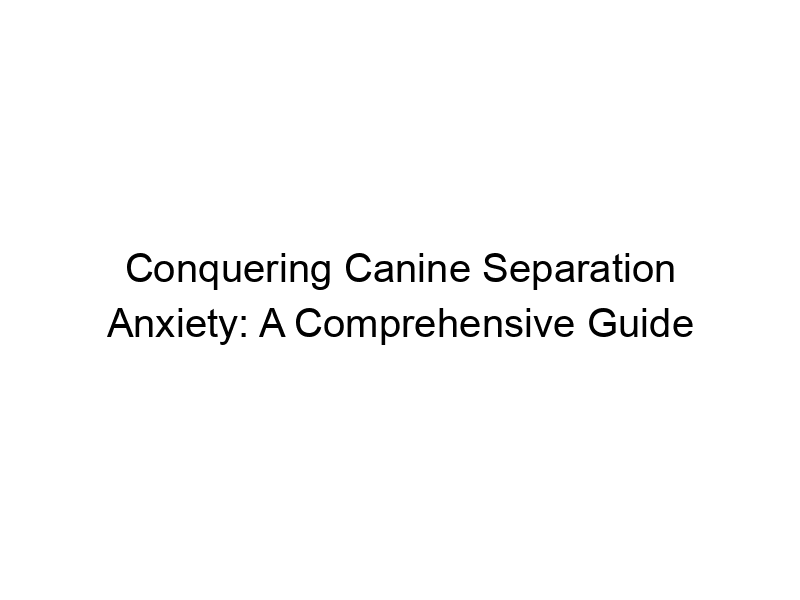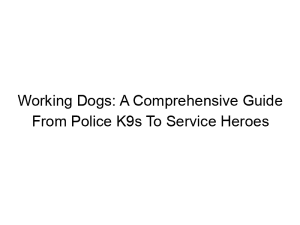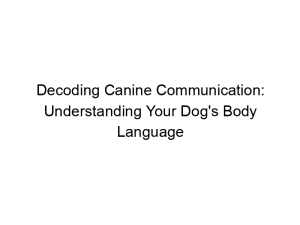It’s heartbreaking to see your beloved dog distressed when you leave. That anxious whining, pacing, destructive chewing – these are all signs of separation anxiety. This comprehensive guide will equip you with the knowledge and strategies to understand, manage, and ultimately help your dog overcome this challenging behavior. You’ll learn about the causes, effective training techniques, environmental modifications, and when professional help might be necessary. Let’s get started on the path to a happier, more relaxed life for both you and your furry friend.
Separation anxiety in dogs is a behavioral disorder characterized by excessive distress when separated from their owner or attachment figure. It’s not simply a dislike of being alone; it’s a deep-seated fear and anxiety manifesting in various ways, including vocalization (whining, barking, howling), destructive behavior (chewing, digging, scratching),
escape attempts, and even self-harm (licking, chewing excessively on paws).
Signs and Symptoms of Separation Anxiety
Recognizing the signs is crucial for early intervention. Common symptoms include excessive panting, drooling, pacing, restlessness before departure, immediate distress upon your leaving, and difficulty settling down when alone. Some dogs may exhibit changes in appetite, sleep disturbances, or house soiling (even if usually housetrained).
Causes of Separation Anxiety
The underlying causes are complex and often multifaceted. Traumatic events like abandonment, adoption from shelters or rescues, changes in routine or environment, or the loss of a companion animal can contribute. Genetic predisposition also plays a role, with some breeds exhibiting higher incidences of separation anxiety.
Diagnosing and Assessing Your Dog’s Anxiety
The Importance of Veterinary Consultation
Before starting any training, it’s crucial to rule out any underlying medical conditions that might be contributing to your dog’s behavior. A vet can perform a physical exam and may suggest blood work to eliminate possible medical issues mimicking anxiety. They can also help assess the severity of the anxiety and recommend appropriate treatment options.
Behavioral Assessments: Understanding the Severity
A certified veterinary behaviorist or professional dog trainer can conduct a thorough behavioral assessment. This involves observing your dog’s behavior in various situations, including during separation, and interviewing you about its history and current habits. This assessment helps determine the extent of the anxiety and guides the development of a tailored treatment plan.
Effective Strategies for Managing Separation Anxiety
Desensitization and Counter-Conditioning
This technique gradually exposes your dog to the cues associated with your leaving (keys jingling, putting on shoes) without causing a significant anxiety response. Initially, the cues are presented at a low intensity, with positive reinforcement (treats, praise) used to create positive associations. The intensity of the cues is gradually increased over time.
Creating a Safe and Comfortable Space
Providing a den or safe space where your dog feels secure and comfortable is essential. This could be a crate (properly introduced and associated with positive experiences), a dog bed in a quiet corner, or even a specially designated room. Make it inviting with their favorite toys, blankets, and a comforting scent (like lavender or chamomile).
Exercise and Mental Stimulation
A tired dog is a less anxious dog. Ensure your dog gets plenty of physical exercise (walks, playtime, fetch) and mental stimulation (puzzles, training games) before you leave. This helps burn off excess energy and reduces anxiety.
Training Techniques for Separation Anxiety
Crate Training for Anxiety Reduction
If used correctly, crate training can provide a secure den and reduce anxiety. Never use the crate as punishment! Instead, associate it with positive experiences, such as feeding times, treats, and comfy bedding. Start with short periods of time and gradually increase the duration as your dog becomes more comfortable.
Positive Reinforcement Training
Focus on rewarding calm behavior. Ignore anxious behaviors and reward calm sitting or lying down. Using high-value treats during training sessions helps to maintain your dog’s focus and increases the effectiveness of the training. The goal is to create a positive association with your absence.
Leave and Return Strategies
Practice short absences, gradually increasing the duration as your dog demonstrates improved coping mechanisms. Your departures and arrivals should be low-key and uneventful, avoiding overly enthusiastic greetings or goodbyes. This helps minimize the anxiety associated with your leaving and returning.
Environmental Modifications to Reduce Anxiety
Adaptil or Feliway Diffusers
These pheromone diffusers release calming scents that can help reduce anxiety in dogs. They mimic the calming pheromones produced by mother dogs, creating a sense of security and well-being. These are a helpful addition to other behavioral modification techniques.
White Noise Machines or Calming Music
White noise machines or calming music can mask distracting sounds and create a more relaxed environment. The consistent sound can help drown out external noises that might trigger anxiety and help your dog feel more secure.
Safe Space Enrichment
Provide engaging activities to keep your dog occupied while you are away. This could include puzzle toys dispensing treats, frozen Kongs filled with peanut butter, or long-lasting chews. This helps to divert attention from your absence and reduces anxiety.
Medication for Separation Anxiety
When Medication is Necessary
In severe cases, medication might be necessary to help manage the anxiety. A veterinarian or veterinary behaviorist can determine if medication is appropriate and prescribe a suitable anxiolytic. Medications should always be used in conjunction with behavioral modification techniques, not as a standalone solution.
Types of Medications Used
Commonly prescribed medications include selective serotonin reuptake inhibitors (SSRIs) and other anti-anxiety medications. These medications are tailored to your dog’s specific needs and work by altering brain chemistry to reduce anxiety. It’s essential to follow your veterinarian’s instructions carefully.
Potential Side Effects of Medication
As with any medication, there are potential side effects to be aware of. These can vary depending on the individual dog and the medication used. Common side effects may include drowsiness, changes in appetite, or gastrointestinal upset. Report any concerning side effects to your veterinarian immediately.
Professional Help for Separation Anxiety
Certified Professional Dog Trainers (CPDT-KA)
Working with a CPDT-KA certified trainer can provide personalized guidance and support. They can assess your dog’s behavior, develop a tailored training plan, and provide hands-on support throughout the process. They are trained in positive reinforcement methods and can address the root causes of your dog’s separation anxiety.
Veterinary Behaviorists (DACVB)
A veterinary behaviorist (DACVB) is a veterinarian who specializes in animal behavior. They can conduct a comprehensive assessment, rule out medical causes, and recommend treatment options that may include medication and behavioral modification techniques. They offer expert advice and help tailor treatment plans to your dog’s specific needs.
Comparing Different Approaches
Medication vs. Behavioral Modification
While medication can be extremely helpful in managing severe anxiety, it’s most effective when used in combination with behavioral modification techniques. Behavioral modification addresses the root cause of the anxiety, making long-term management more sustainable. Medication can help manage symptoms while the behavioral changes take effect.
DIY vs. Professional Help
While many techniques can be implemented at home, professional help is invaluable for severe cases or if you’re struggling to see progress. A professional can provide personalized guidance, tailored strategies, and ongoing support, ultimately leading to faster and more effective results. Don’t hesitate to seek help if needed.
Preventing Separation Anxiety
Early Socialization and Training
Early socialization is key to preventing separation anxiety. Expose your puppy to various environments, people, and animals from a young age. Begin crate training early and positively reinforce calm behavior from the start. This helps your dog learn to be comfortable and independent.
Gradual Introduction to Alone Time
Gradually increase the duration of alone time from a young age. Start with short periods and gradually lengthen them. This helps them adjust to being alone without experiencing significant distress. Consistency and positive reinforcement are crucial.
Frequently Asked Questions
What are the long-term effects of untreated separation anxiety?
Untreated separation anxiety can lead to several problems. These include persistent fear and anxiety, increased destructive behaviors, worsening self-harm, and even health problems due to stress. The dog’s overall quality of life is significantly diminished, impacting both the dog and owner’s well-being.
How long does it take to overcome separation anxiety?
The time it takes varies depending on the severity of the anxiety, the dog’s temperament, and the effectiveness of the chosen approach. Some dogs may show improvement within a few weeks, while others may require several months or even longer. Consistency is key, and progress might not be linear.
Can separation anxiety be cured completely?
While a complete “cure” isn’t always possible, significant improvement and management are achievable. With consistent training, environmental modifications, and possibly medication, many dogs can learn to cope with separation, minimizing or eliminating the severe behavioral manifestations of anxiety. The goal is effective management, not necessarily elimination.
Final Thoughts
Helping your dog overcome separation anxiety requires patience, understanding, and a commitment to consistent effort. By combining appropriate training techniques, environmental adjustments, and potentially medication (under veterinary guidance), you can significantly improve your dog’s well-being and create a happier home for both of you. Remember, it’s a journey, not a race. Celebrate small victories along the way, and don’t hesitate to seek professional help when needed. A calm, confident, and well-adjusted canine companion is within reach. Start your journey today, and witness the transformative power of understanding and support in overcoming this common canine challenge.




